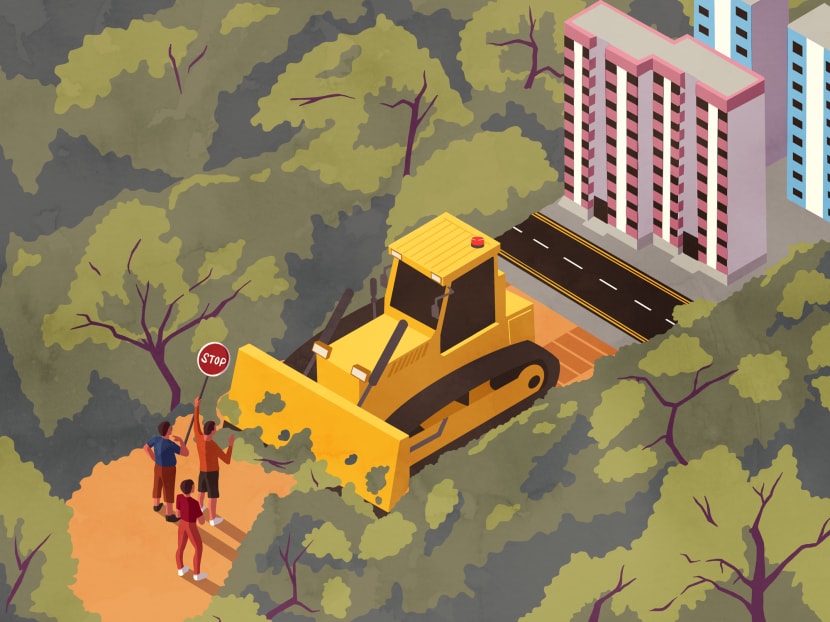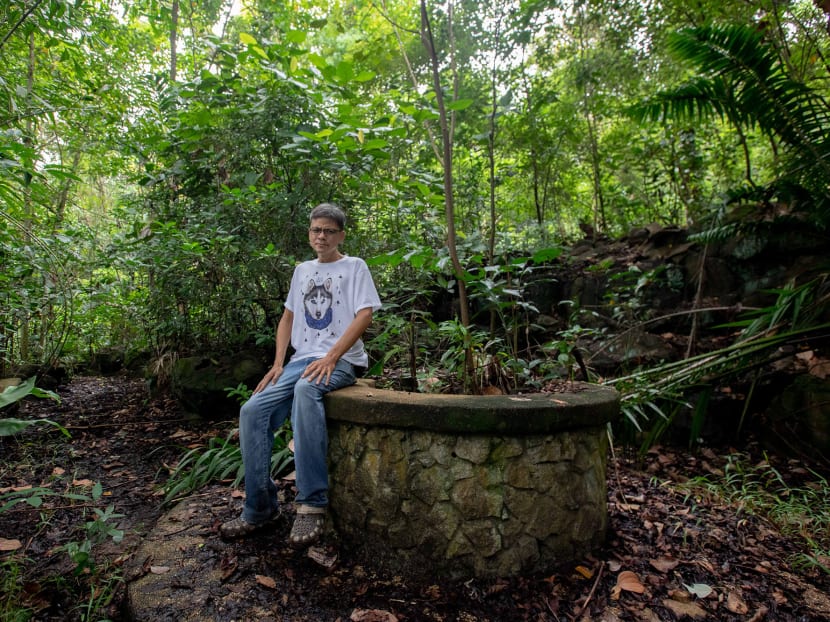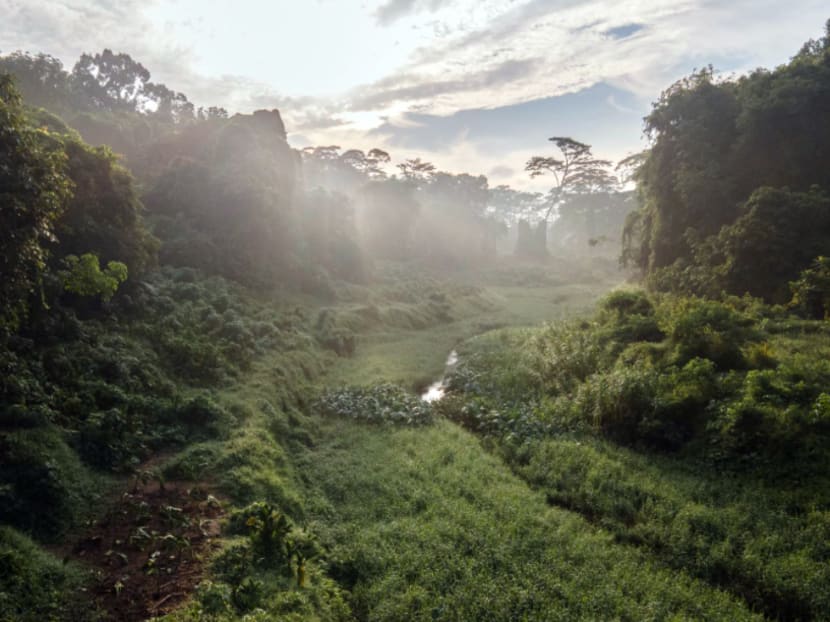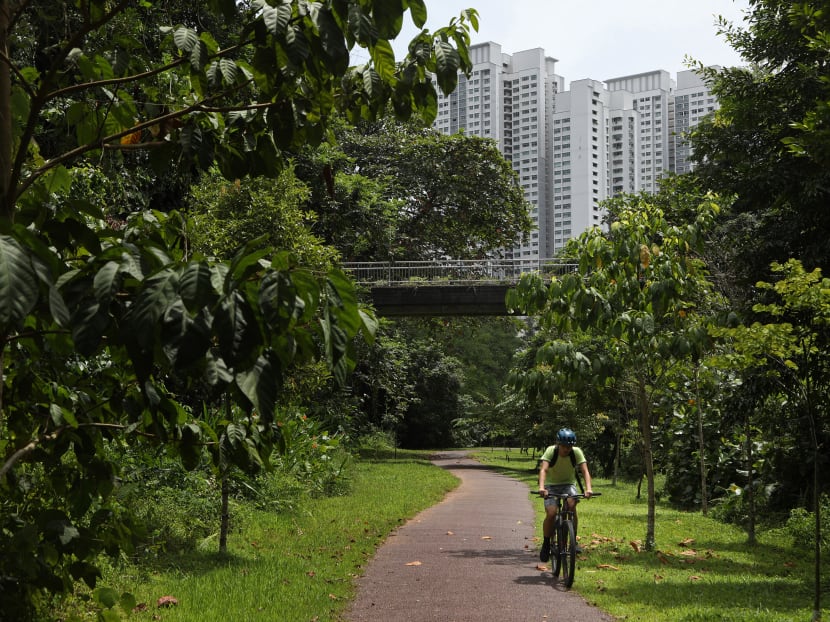The Big Read: As clamour grows for preservation in land-scarce S’pore, something’s got to give
SINGAPORE — Over the past decade, Mr Jimmy Tan has seen lush greenery in Singapore being taken down one by one. In 2012, Bidadari cemetery, a safe haven for endangered birds, was cleared for a new Housing and Development Board (HDB) town.

In land-scarce and densely populated Singapore, the Government will have to continue balancing the needs of development and conservation as part of its long-term planning processes, said National Development Minister Desmond Lee.
- Calls to preserve Singapore’s natural greenery have been growing among the public, with the issue set to be discussed in Parliament next week
- Nature groups say that since the Bukit Brown saga about a decade ago, the Govt has taken pains to deepen its engagement with them
- But the groups added that these conversations need to move beyond the narrative of prioritising development first
- Some young S’poreans interviewed say they are committed to safekeeping green spaces for future generations
SINGAPORE — Over the past decade, Mr Jimmy Tan has seen lush greenery in Singapore being taken down one by one.
In 2012, Bidadari cemetery, a safe haven for endangered birds, was cleared for a new Housing and Development Board (HDB) town.
In 2016, the HDB announced plans to build a “forest town” in Tengah which, according to the Nature Society, would eliminate over 90 per cent of the original forest there.
The same year, the verdant 30-hectare Lentor Forest near Yio Chu Kang was razed for private housing.
The “final straw” for Mr Tan, a 48-year-old Bukit Batok resident, was when he found out in July last year — after a public feedback exercise by HDB — that there were plans to develop parts of the Bukit Batok Hillside Park area into Build-to-Order (BTO) flats.
“While on its own, Bukit Batok Hillside Park is a small forest on the map, it is a seamless eco-corridor (for wildlife to travel) connecting Tengah to Bukit Timah. So if Bukit Batok forest is developed, it’ll definitely affect the movement of wildlife between these two areas,” said Mr Tan.
Worried that its development would take down the “last stronghold” for biodiversity in the western area, Mr Tan launched an online petition in August last year calling for the preservation of the park. The petition on Change.org has garnered over 13,000 signatures, exceeding his expectations.

A flurry of online petitions have followed since, calling for the preservation of other green spaces in Singapore.
In October last year, an online petition to preserve Clementi Forest, which has been zoned for residential use since 1998, was put up after drone footage capturing the beauty of the forest went viral on social media.
Earlier this month, an online petition to save Dover Forest, which is slated to make way for new flats this year, was put up by Mr Sydney Cheong, a 52-year-old resident of Dover Estate.
The public calls have also found their way into the august chamber, with Members of Parliament (MPs) raising the issue recently.
Mr Dennis Tan, the Workers’ Party MP for Hougang, asked in a parliamentary question earlier this month if the Government would consider reviewing the status of Clementi Forest, while Jurong Group Representation Constituency (GRC) MP Tan Wu Meng, from the People’s Action Party, had asked if Clementi Forest can be designated as a national park or nature reserve.
In separate written responses to both MPs, National Development Minister Desmond Lee said that while there is no immediate need to develop Clementi Forest, which is earmarked for residential use, the Government will retain its zoning status and allow future generations to decide what to use it for.
In land-scarce and densely populated Singapore, the Government will have to continue balancing the needs of development and conservation as part of its long-term planning processes, said Mr Lee.
“After weighing the alternatives and trade-offs, there will be areas that we cannot avoid developing. Nonetheless, for these sites, possible environmental impacts will still be carefully managed, and natural elements will be integrated within developments where possible,” he added.
However, the debate over the preservation of forests in Singapore looks set to continue next week, with Mr Christopher de Souza, an MP for Holland-Bukit Timah GRC, filing an adjournment motion to speak on the preservation of Dover Forest in Ulu Pandan.
When contacted, Mr de Souza referred TODAY to his Facebook post on Jan 18, in which he said he will raise possible alternative sites for housing in Dover, and speak about preserving natural and sustainable spaces in his Ulu Pandan ward during his speech in Parliament.
“I support housing and redevelopment. But, I also cherish greenery and the serenity it offers people and wildlife,” he added.
Clementi and Dover forests are both located within Mr de Souza’s GRC.
His adjournment motion filed for the Parliamentary sitting on Monday (Feb 1) will be heard alongside the first-ever motion on climate change — filed by MPs from the Government Parliamentary Committee for sustainability and the environment, which is led by Mr Louis Ng of Nee Soon GRC.
The motion puts forth several recommendations, including increasing public access to emission data of private companies, which aim to bolster Singapore’s efforts against climate change.

Against the backdrop of growing environmental consciousness around the world, the calls to preserve the two forests in Singapore mark the latest chapter in the perennial “preservation-versus-development” conundrum. It comes about a decade after the Bukit Brown saga which saw things come to a head between environmentalists and the Government.
At that time, the Government had gone ahead with plans to build a road through the former cemetery at Bukit Brown to reduce traffic congestion in the area, even though heritage and nature groups had protested against the move during the consultation exercise.
Since that episode, the Government has engaged more intensely with nature groups, said Dr Ho Hua Chew, the vice-president of Nature Society.
Consultations over the Cross Island MRT Line’s route went on for a good six years and are still on-going, even after the Government decided in 2019 to run the line directly under the Central Catchment Nature Reserve.
While green groups that TODAY spoke to agreed that the Government has become more receptive to their views, they believe it is now time to put conservation or preservation at the front and centre of future development projects.
In this week’s Big Read, TODAY looks at the increasing clamour among Singaporeans to protect their green spaces and whether a fresh approach towards development is possible in a country with limited land.
GREATER INTEREST IN PRESERVATION THANKS TO COVID-19?
Mr Yeo Wei Jiang from the Singapore University of Social Sciences (SUSS) has been spending more time outdoors in the last four years.
The 24-year-old first-year marketing student has not only climbed the mountains of Taiwan and Japan, he has also spent the last year exploring local nature reserves such as Bukit Timah and the Central Catchment area.
These hikes have made him more conscious of man’s impact on green areas, and Mr Yeo has come to believe that the preservation of forests is important.
During his overseas hikes, he has observed how much of the forests and ecosystems of these countries have been cleared for human development.
“I don’t think we want Singapore to end up in a similar situation. As it is, I’ve observed signs of humans encroaching in green areas, leaving litter behind,” said Mr Yeo.
Observers noted that the Covid-19 pandemic, which started early last year, has indirectly led to an “all-time high” interest in conservation or preservation efforts in Singapore.
Unable to travel, Singaporeans have now turned to hiking to pass their time. The exploration of their own backyards has also led to a greater appreciation of the concrete jungle’s remaining green areas, they noted.
TODAY had reported last November that Singapore was experiencing a hiking boom following the circuit breaker period from April to June.
“I think the general public is more appreciative of wild greenery rather than a manicured park. Bashing through some wild areas gives you a different feel from walking along a park connector,” said Mr Leong Kwok Peng, who chairs the Nature Society’s conservation committee.
Moreover, scenic pictures uploaded on social media, such as the viral photo of Clementi Forest posted by nature enthusiast Brice Li last year, have also opened up Singaporeans’ eyes to the greenery in their own backyard.
As such, there is a growing concern among Singaporeans that such experiences, which are scarce here, may be gone once forests are developed, noted Mr Leong, 64. He added that this has spurred more individuals to press for the conservation or preservation of green spaces, independent of similar efforts undertaken by nature groups all these years.
The ground sentiment has, in turn, led to MPs raising the issue in Parliament. “It’s good that it’s not just the voice of Nature Society, but also the voice of residents who care about what is around them,” said Mr Leong. He noted that Mr de Souza’s adjournment motion could be the first time that an MP is raising the issue of environmental conservation or preservation in his or her constituency.
Indeed, Dr Tan, the MP for Jurong GRC, said that although Clementi Forest is not within his constituency, he was prompted to raise the issue in Parliament after many of his residents brought it to his attention. They did so by showing him viral pictures of the forest, or writing to him on the forest’s contribution to Singapore’s biodiversity.
“It was a real mix of views but amid the diversity of views, there was this sense of interest in the issues and I thought I’d give a sense or voice (in Parliament) about what my residents were talking about,” said Dr Tan.
Greater awareness of environmental issues among young people, coupled with the advent of social media, has led to more making their voices heard, said observers.
Mr Karl Png, 23, the founder of Singapore Youth Voices for Biodiversity, said that young people in general are more “woke” about environmentalism.
“There are definitely more young people concerned about the environment due to social media, news reports and environmental role models like (Swedish teenager) Greta Thunberg who inspire a young generation of people,” he said.
Mr Png, who is a Dover resident, has put up on Facebook infographics made by his organisation on HDB’s Environmental Baseline Study of Dover Forest. He has also been in talks with residents and other youth groups on how best to raise awareness of, and preserve, Dover Forest.

Another youth environmental group, Speak for Climate, has also been active in using social media to get the general public on board with its conservation or preservation efforts.
In the case of Dover Forest for example, the group has come up with templates for people to communicate their concerns to MPs and participate in the public feedback process led by HDB.
EVOLUTION OF GOVT ENGAGEMENT
While they still do not see eye-to-eye on various issues, the Government’s consultation process with environmentalists has improved in the last two decades, the latter told TODAY.
In particular, the Government’s engagement with green groups on Bukit Brown cemetery and Chek Jawa in Pulau Ubin were turning points, noted Nature Society’s Dr Ho.
In 2001, a public campaign was mounted to save Chek Jawa after it came to light that parts of the wetlands would go through reclamation works to turn it into a military training area in future. Reclamation works were eventually deferred after appeals by nature groups and the public.
A less successful case for the environmentalists was Bukit Brown. In 2011, the Government announced that it would run an eight-lane road through the cemetery, which the Nature Society had identified for conservation since 1990 due to its biodiversity.
However, a meeting between then Minister of State for National Development Tan Chuan-Jin and nature and heritage groups ended on a sour note in March 2012 when the authorities said they had no intention to revise the plan.
A statement released by the groups after the meeting said that there was a “lack of good faith” by the Ministry of National Development during the meeting, while Mr Tan — who is currently the Speaker of Parliament — later said that the dialogue had never been “a consultation effort to debate” the issue.
In the cases of Chek Jawa and Bukit Brown, the issues spilled over to the wider public, noted Dr Ho.
Bukit Brown, in particular, was significant as it did not involve nature groups alone, he added.
“This, I believe, led later to the more intense consultation with a wider array of (nature) groups, in the case of the Cross Island Line,” he noted.
Other environmentalists also agreed that the Cross Island Line was significant for the level of engagement between the Government and nature groups.
For one, unlike previous projects, nature groups were involved in consultations even before the Environmental Impact Assessment (EIA) was conducted, said Mr N Sivasothi of NUS Toddycats, a volunteer group with the Lee Kong Chian Natural History Museum at the National University of Singapore (NUS).
This allowed the groups to give their input on what should be assessed in the report, the 54-year-old said.
Despite the final decision to run the route through the catchment, the Government took on suggestions by the groups to mitigate the impact of damage caused by construction work on the line, said Mr Sivasothi, a senior lecturer at NUS’ Department of Biological Sciences.
For example, the initial estimate by the authorities to drill 72 boreholes to extract soil samples was brought down to 16, said Mr Sivasothi.
However, environmentalists say future engagements should involve them as early as possible.
Citing the example of the Cross Island Line, Dr Vilma D'Rozario, director of Singapore Wildcat Action Group (Swag), said that while the decision on the route was still not firm at the start, she could tell that a lot of discussion and work had much earlier gone into the concept of having the rail go under the forest.
As such, nature groups did a lot to mitigate the impact of the final decision, and saw success in that area, she pointed out.
However, involving nature groups even earlier would have helped the Government to consider an alternative route — an option that the authorities had not considered until the groups suggested it during the Cross Island Line engagements, said Dr D’Rozario.
She suggested that groups be engaged as early as the creation of master plans instead of further down the road, when decisions have already been made and nature groups are engaged to work on mitigation measures and monitor them.

The Master Plan is a land use plan developed by the Urban Redevelopment Authority to guide Singapore’s development over the next 10 to 15 years. It is based on the longer-term Concept Plan for land use, and is reviewed every five years.
Being involved at the Master Plan stage would also help nature groups understand the constraints involved in policy-making and help to develop solutions with planners, Dr D’Rozario added.
Environmentalists also felt that there could be better coordination among different government agencies when engaging nature groups.
Dr Ho gave the example of the Tengah Forest Town project, which involves multiple agencies such as HDB, the National Parks Board (NParks) and the Land Transport Authority (LTA).
He said that Nature Society had initially held meetings with HDB around 2016 over plans for a nature way which allows wildlife to move from Bukit Timah and the Central Catchment Nature Reserves to the Western Catchment and back.
The western flank of the nature way will serve as a launching base that enables animals to cross over the Kranji Expressway into the Western Catchment and vice versa without ending up as road kill.
However, as LTA was clearing a large patch of the forest in the western sector close to the planned nature way for its own road project, it adversely limited the siting and suitability of the planned eco-link at this western sector across the Kranji Expressway, said Dr Ho.
“I believe an earlier multi-sector pow-vow on this issue that was eventually carried would have been better,” he added.
ARE WE READY FOR THE TRADE-OFFS?
While deeper engagement with the Government is welcomed, environmentalists told TODAY that it is also time to relook Singapore's approach to development as a whole, by making conservation or preservation the centerpiece.
Marine conservationist Kathy Xu, 38, said that even as the Government continues to prioritise development, the country will eventually have to face up to its consequences, such as losing habitats and rising sea levels.
“We as a nation chose to say that development is necessary, and we bear the consequences of what will happen to us in the coming years. There are only so many times we can talk about it and not do anything about it,” she said.
While the Government’s priority on development was understandable in the years immediately after independence, the time has come to adopt an eco-centric approach to development — one that allows for dense secondary forests to remain and support biodiversity which parks cannot do, said Mr Jimmy Tan, the petitioner for Bukit Batok Hillside Park.
In December last year, Mr Lee, the National Development Minister, announced that two new parks at Bukit Batok will be built in the area to promote greater ecological connectivity between Bukit Timah Nature Reserve and Tengah.
Several environmentalists also questioned the familiar refrain that Singapore is land scarce.
Dr Ho noted that the country has 1,500 hectares set aside for golf courses — more than one-and-a-half times the size of Pulau Ubin. Scarcity depends on how the land is used, he reiterated.
Dr Andie Ang, a research scientist at Wildlife Reserves Singapore Conservation Fund, said that with wild habitats such as forests already in a state of imbalance, there needs to be a discussion on how much forest cover the country wants to retain.
Instead of clearing forests immediately when the country needs land, different sites — including forests, car parks and golf courses — should be assessed for their value and utilisation to their community. For instance, a single-level carpark may be converted to a multi-storey one to better utilise space and free up areas for development, said Dr Ang, 36.
A joint study by researchers from Singapore-ETH Centre, Campus for Research Excellence and Technological Enterprise and NParks in 2019 showed that Singapore’s secondary forests made up about 20 per cent of its land cover. While Previous studies of Singapore’s primary forest cover put this number at a mere 0.16 per cent.
However, policy experts said that any form of development will entail hard trade-offs.
While the Government has tried to intentionally incorporate green spaces into new housing and urban developments, it may not always be possible to leave secondary forests untouched, said Dr Woo Jun Jie, a senior research fellow at NUS’ Institute of Policy Studies.
This is especially so given the high demand for public housing in Singapore, as can be seen by BTO launches which continue to be oversubscribed, said Dr Woo.
In his response to Dr Tan Wu Meng’s parliamentary questions earlier this month, Mr Lee, the National Development Minister, had also pointed out that demand for HDB flats is likely to remain strong, with more families becoming nuclear households and singles aspiring for their own homes.
With Singapore’s population projected to grow, the demand for space is unlikely to abate.

The Government had said in 2013 that Singapore will need an additional 5,600 hectares of land to build 700,000 new homes and facilities by 2030. This additional land will come from reclaimed land, reserved land and “recycled” land such as golf courses when their leases expire.
Instead of bulldozing forests, environmentalists and some members of the public interviewed by TODAY suggested that alternative sites be considered for public housing, such as vacant schools, underused car parks and brownfield sites.
Improvements in technology could also allow for taller buildings to be built on smaller plots of land, they said.
However, policy experts said that it is not as simple as building houses at another spot. Urban planning involves considering housing estates’ proximity to basic amenities, transport connectivity, as well as their population density.
The relatively small size of alternative sites may also not be enough for the Government’s town planning purpose, which typically requires larger plots of land, said Dr Woo.
Nevertheless, he said that there is scope for the planning process to incorporate even more public feedback.
Planners could take into consideration public feedback at the implementation or control plan stages. This could be institutionalised and made part of the Government’s urban planning processes, said Dr Woo.
However, consulting green groups, particularly at the review stages of the Master Plan, could result in delays to the land planning process, said Dr Steven Choo, an adjunct associate professor in urban planning at NUS.
Still, even if delays were to occur, it is better off to ensure a higher quality of urban planning, which can minimise the impact on the environment and improve the overall quality of life for residents, said Dr Ang from the Wildlife Reserves Singapore Conservation Fund. Feedback at an early stage would also help planners to understand what residents want and to build accordingly.
SAFEGUARDING LAND FOR FUTURE GENERATIONS
Ahead of the adjournment motion over Dover Forest’s status in Parliament next week, the Government has already signalled that it will listen carefully to the views of the public before making a final decision on the site.
In a Facebook post following a visit to Dover Forest with several groups earlier this week, Mr Lee the National Development Minister said that the Government will consider possible plans for the site.
He noted that previous generations had kept aside land for future generations to use. Singaporeans today must, in turn, safeguard land for future generations, he added.
“We need to provide for current and future need for homes, jobs and other amenities, and at the same time secure green and blue spaces for Singaporeans,” he said.
He noted that over the years, green spaces initially designated for other sites such as factories have been set aside as nature parks instead, given their ecological importance.
“We are looking at more possibilities, to enhance ecological connectivity and provide more green spaces for Singaporeans,” he added.
Mr Lee said that the Government will “proceed with care” when developing near areas of significant biodiversity, and preserve and integrate natural elements within developments as far as possible.
“These are the same considerations for balancing greenery and conservation on the one hand, and providing future homes on the other, in the Ulu Pandan area. These are both important needs, and we should not rush into a decision,” said Mr Lee. He added that detailed plans will be shared for Dover Forest when ready.

Swag’s Dr D’Rozario is optimistic that the Government is prepared to change its stance if there is a strong case for conservation or preservation.
She pointed to the Government’s efforts to protect mature secondary forests — such as the Rifle Range Nature Park and the Dairy Farm Nature Park — around core primary forests.
Meanwhile, environmentalists are hoping that the general public’s clamour for conservation or preservation is not just a passing fad.
“Now with social media, people’s attention span is really short. I’m afraid they will forget about Clementi Forest and Dover Forest,” said Ms Xu, the marine conservationist. Once travel restrictions are lifted and Singaporeans start flocking overseas again, the public may no longer be in the “long-haul fight”, she added.
Some young Singaporeans whom TODAY spoke to said they are well aware of the long-term implications of deforestation and climate change.
Mr Yeo, the undergraduate from SUSS, reiterated that preserving the natural environment should be Singapore’s “top priority”.
“I am willing to commit to it even if it means waiting longer for a BTO, living in a more inconvenient area or paying a higher price,” he said.
For young environmentalist Mr Png, who had discussed Dover Forest’s status with Mr Lee on Thursday, it is “quite frightening” to envision a Singapore obsessed with urban productivity and unable to see the benefits and value of nature.
“If we can't see the trade-offs by cutting down more forests, future generations may not be able to appreciate nature and eventually lead to our self-demise when we cut the last tree down,” he said.











